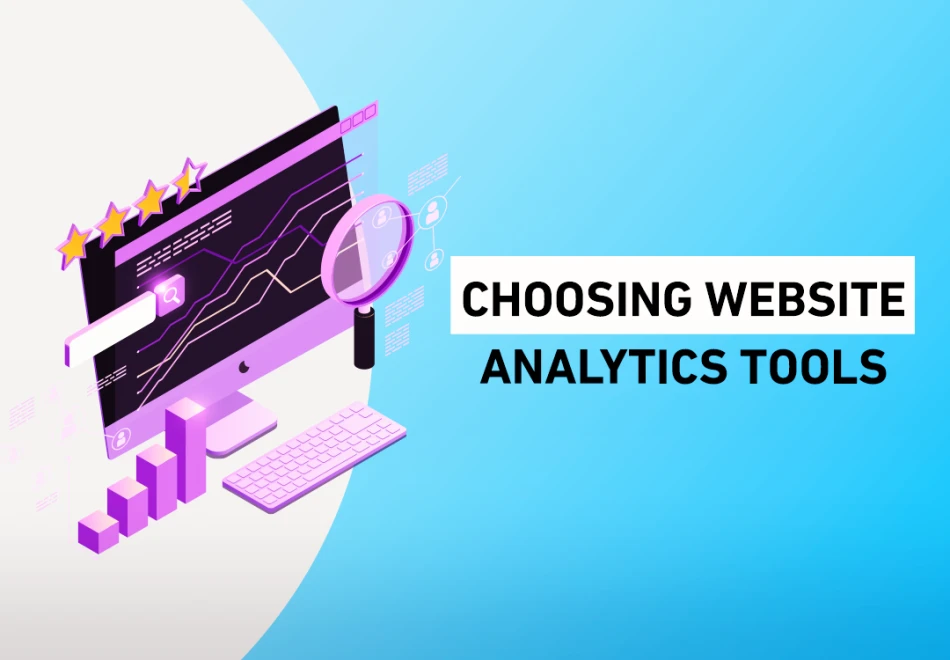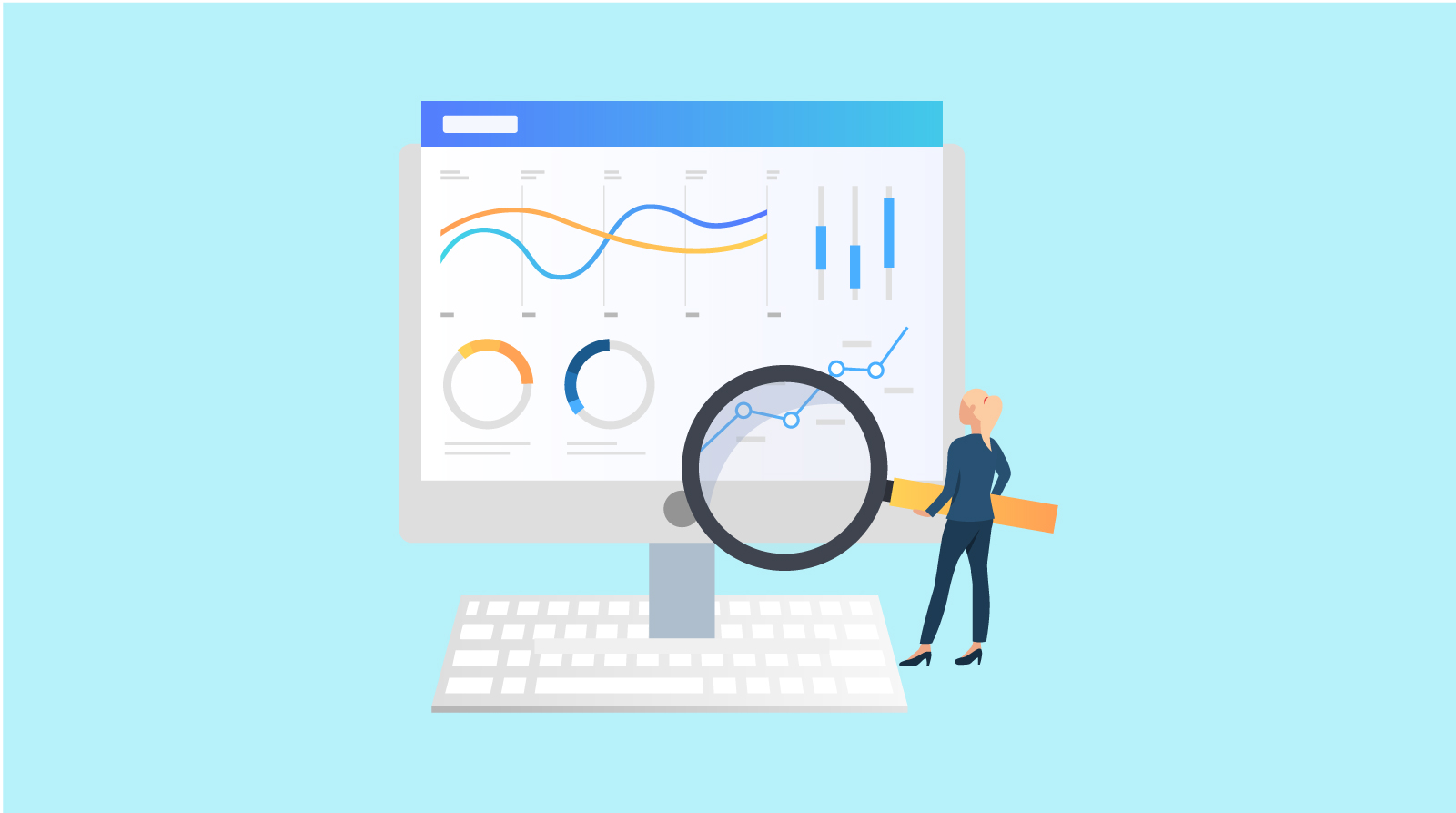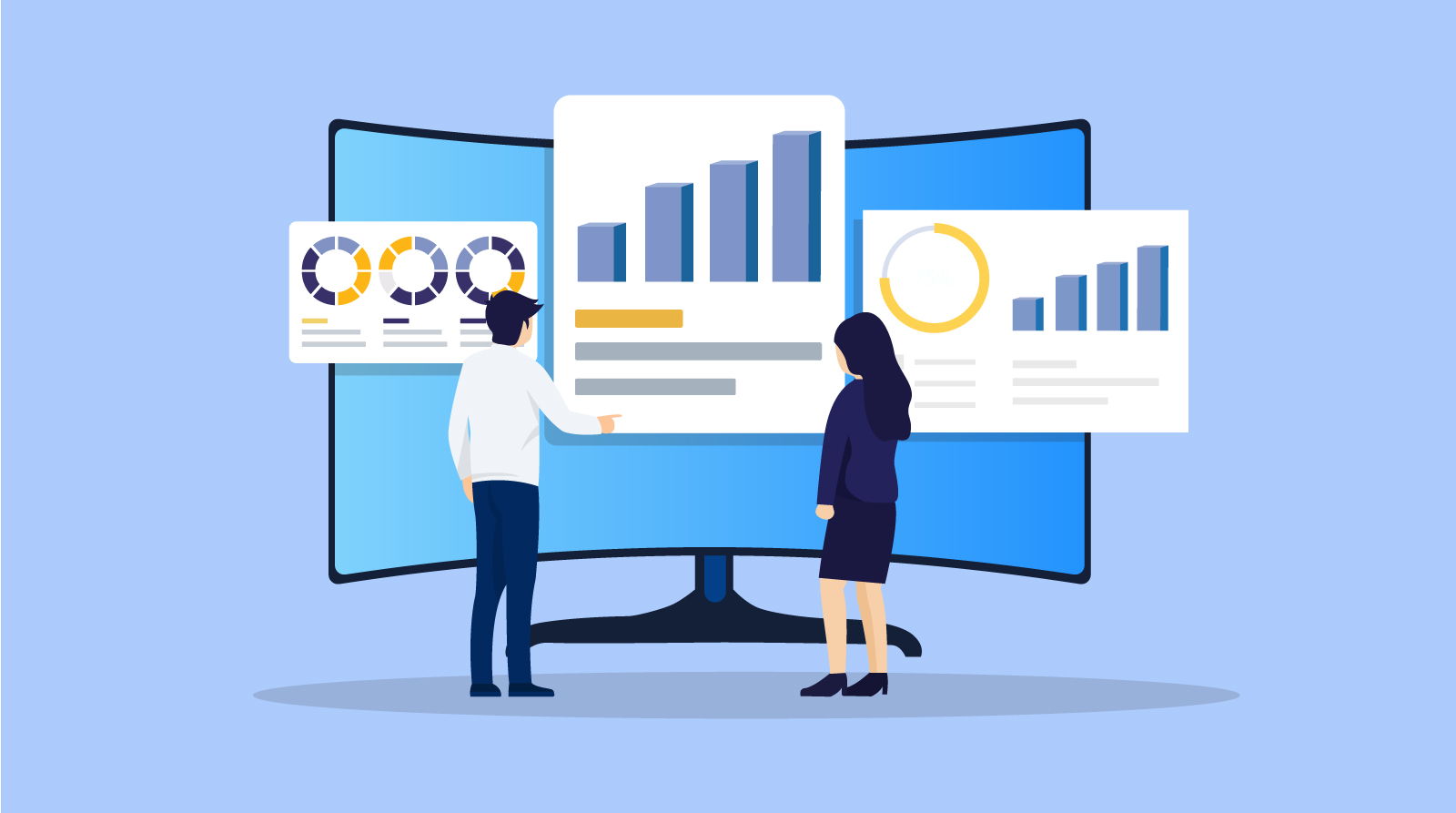17 Insights for Choosing Website Analytics Tools Like a Pro

Your website isn’t just a place to show off your products or services—it’s full of hidden data insights just waiting to be discovered.
The right website analytics tools can help you figure out what’s working on your site, what isn’t, and how to make it better.
They go beyond just showing numbers; they give you a clear picture of how visitors interact with your site and where you can improve.
In this guide, I’ll walk you through the best website analytics tools I’ve tried out.
I’ll keep it simple, breaking down their features, what they’re great at, and where they might fall short.

What Is Website Analytics?
Website analytics tools give you the data insights you need to track performance and understand how people interact with your website.
They show you how often visitors show up, where they’re coming from, how long they stay, and what they do once they’re on your site.
Visitor traffic analysis is often where it all begins.
With most website analytics tools, you can see how many people visit, which pages they look at, and whether they come back.
This reveals important data insights about your traffic sources, so you can fine-tune your marketing and make sure you’re reaching the right people.
User behavior analysis goes deeper into how visitors navigate your site.
By watching where they click or how they scroll, you can spot what grabs their attention and figure out if there’s anything confusing or missing.
Conversion tracking then shows whether visitors are taking important actions, like filling out forms or buying products.
If you see low conversion rates, you can use these data insights to tweak your site’s design or adjust your marketing tactics.
Performance monitoring helps ensure your site runs smoothly.
With website analytics tools, you can stay on top of page load times and other metrics, so you’re always tracking performance.
A slow site can turn visitors off, so catching and fixing issues quickly is a must.
Finally, Audience interest tracking reveals which content, products, or topics resonate most with your visitors.
What Are Website Analytics Tools?
Website analytics tools are software programs that track and analyze what visitors do on your website.
They help you figure out how many people visit, where they come from, which pages they view, and how long they stick around.
Here’s why these tools are so useful:
Make Your Site Easier to Use: Analytics tools show which pages people spend the most time on and how they move through your site. If visitors seem to get lost or leave quickly, you can tweak your site to make it simpler and more enjoyable to navigate.
Increase Sales or Sign-Ups: Want more people to complete actions like buying a product or signing up for your newsletter? These tools show you how well your site is doing at converting visitors into customers and give you clues on what to improve if conversions are low.
Fine-Tune Your Marketing: Not sure which of your ads or campaigns are working? Website analytics tools can show you which marketing channels bring in the most visitors and which ones lead to sales.
What Are the Different Types of Web Analytics Tools?
1. On-site/Hosted
On-site or hosted website analytics tools are designed to provide unique data insights by installing a small piece of code directly on your website.
This code tracks everything happening on your site, from the number of visitors and their traffic sources to how they navigate your pages and what actions they take.
For example, popular tools like Google Analytics and Clicky work this way.
They help you with tracking performance by showing detailed metrics, such as which pages attract the most attention or where visitors drop off.
Since the data is tied specifically to your website, these tools are perfect if you want customized analytics.
You also have full control over the data collection process, making it easier to tailor reports and focus on what matters most for improving your site.
2. Third-party/Off-site
Third-party or off-site website analytics tools gather data insights from outside sources like search engines, toolbars, or other tracking systems.
The best part?
You don’t need to add any code to your site to use them.
Instead, these tools analyze multiple websites, making them ideal for tracking performance across the web and doing competitive analysis.
Take SimilarWeb, for example.
It gives you a big-picture view by comparing your website to others in your industry.
You can see how your site stacks up, identify trends, and find opportunities to grow.
These tools are especially handy if you’re trying to understand your market or benchmark against competitors.
What Are the Categories of Website Analytics Tools?
1. Basic Traffic Analytics
Basic traffic analytics tools are great for understanding the big picture of what’s happening on your website.
They focus on key metrics like how many people visit, how many pages they look at, and basic user actions.
A popular example is Google Analytics, which gives you data insights about where your visitors are coming from—like search engines, social media, or direct links—and how they navigate your site.
These tools are perfect if you’re just starting with website analytics or want a quick snapshot of your site’s performance tracking.
2. Behavioral Analytics
Behavioral analytics tools give you a deeper look at how people interact with your website.
They show where users click, scroll, and move their mouse by using features like heatmaps, session recordings, and form analytics.
For instance, Hotjar and Crazy Egg visually map out which parts of your site attract the most attention and where visitors lose interest.
This level of detail helps you spot problem areas and make improvements that lead to a smoother, more engaging user experience.
3. Conversion Rate Optimization (CRO) Tools
Conversion Rate Optimization (CRO) tools help you get more visitors to take action on your website—whether that’s signing up for a newsletter, making a purchase, or filling out a form.
They focus on making your site more effective at turning visitors into customers.
These tools often include features like:
A/B Testing: Comparing two versions of a page to see which one works better.
Funnel Analysis: Tracking the steps users take before completing an action, so you can see where they drop off.
Landing Page Optimization: Fine-tuning the pages where visitors first arrive to make them more engaging and effective.
Tools like Optimizely and Unbounce make it easy to test out design tweaks or content changes.
They help you figure out what works best to boost conversions without relying on guesswork.
4. SEO Analytics Tools
SEO Analytics Tools are a special type of website analytics tools that focus on helping your site rank higher in search results.
They give you data insights into how well your pages are performing and make tracking performance simple so you can make changes that boost your online presence.
They’re perfect for tasks like:
Tracking Keywords: Discover which terms bring visitors to your site.
Analyzing Backlinks: Find out who’s linking to your site and uncover new link-building opportunities.
Optimizing On-Page SEO: Get suggestions on how to improve your content and structure so you rank higher in search results.
Tools like SEMrush and Ahrefs highlight what’s working and what needs attention.
They show you which keywords drive the most traffic, reveal potential links you can pursue, and give you clear steps to improve your rankings.
Looking for a streamlined way to create and manage your fully optimized website?
That’s where Alweb comes in. With Alweb, you can build a professional, SEO-ready website in just 60 seconds—no coding required.
You’ll have access to advanced analytics for deeper performance tracking, secure professional email, and seamless integration with Google Analytics, Facebook, TikTok, and more.
It’s the perfect way to unite your SEO efforts with a site that’s built for success right from the start.
5. Social Media Analytics
Social media analytics tools make it easier to see how well your posts are doing on platforms like Facebook, Instagram, and Twitter.
They give you clear data insights about how people are interacting with your content—like how many likes, comments, and shares your posts get.
These tools also show you how many people see your posts (your reach) and help you understand the overall success of your social media campaigns.
These tools are great for figuring out what’s working and what’s not.
For example, they can show you if a recent post connected with your audience or if you need to try something different.
This information helps you tweak your strategy to create posts that grab attention, keep your audience engaged, and achieve your goals.
Tools like Hootsuite and Buffer make managing your social media much simpler.
They let you track your activity across all your platforms in one place, so you can see how your campaigns are performing and make improvements as needed.
6. Real-Time Analytics
Real-time analytics tools let you see what’s happening on your website right this second.
They give you instant data insights about how many people are on your site, which pages they’re looking at, and what they’re doing in real-time.
It’s like having a live feed of your website’s activity.
For example, tools like Google Analytics Real-Time and Clicky show you exactly what’s going on as it happens.
Whether you’re running a big campaign, launching a new product, or noticing a sudden spike in traffic, these tools help you stay in the know and react quickly.
7. Customer Journey Analytics Tools
Customer journey analytics tools help you see how people interact with your brand across different channels.
These tools, a key type of website analytics tools, give you data insights about every step of a customer’s journey—from when they first visit your site or click on an ad, to when they complete an action like making a purchase or signing up for a service.
A tool like Woopra is great for tracking performance across multiple touchpoints, such as your website, email campaigns, and mobile apps.
It shows you how customers move through their journey, highlighting patterns and any areas where they might be getting stuck.
This helps you find ways to improve their experience at every stage.
8. Content Analytics Tools
Content analytics tools help you see how well your website’s content is doing.
They provide data insights about how your audience interacts with your articles, blog posts, videos, or any other type of content.
These tools show you what’s working and what’s not, so you can create more of what your audience loves.
For example, tools like Chartbeat are great for tracking performance of your content.
They give you real-time data, showing how many people are reading, how long they stay, and which pieces are getting the most attention.
What Are the Top Website Analytics Tools to Use?
1. Google Analytics
Google Analytics is one of the most popular website analytics tools, offering powerful data insights into how customers interact with your site and apps.
It’s free and helps businesses of all sizes understand customer behavior across devices and platforms.
From tracking the customer journey to predicting user behavior using machine learning, it’s a tool designed to help you improve ROI and make smarter decisions.
It also makes tracking performance seamless by integrating with other Google tools like Google Ads and Google Search Console.
This means you can connect your insights directly to your marketing efforts for real-world results.
Pros:
Free to use.
Tracks user behavior across platforms.
Integrates well with Google tools.
Uses machine learning for predictive insights.
Easy-to-use interface with shareable reports.
Cons:
Can be overwhelming for beginners.
Data sharing may raise privacy concerns.
Limited customization for advanced needs.
Large datasets may show sampled data instead of exact figures.
2. Adobe Analytics
Adobe Analytics is a high-end website analytics tool that helps businesses get detailed data insights about customer behavior across different channels.
It’s part of the Adobe Experience Cloud, making it a great choice for companies that want their analytics to work seamlessly with marketing and content management tools.
This tool is all about advanced reporting and real-time tracking.
It lets businesses monitor user activity closely, spot trends, and make smarter decisions.
Thanks to machine learning powered by Adobe Sensei, Adobe Analytics can even predict customer actions and help optimize marketing strategies.
It’s especially useful for big companies handling complex digital setups.
For example, Kyndryl uses Adobe Analytics to manage content, improve personalization, and track performance across websites, email campaigns, and CRM systems.
Plus, it works effortlessly with other Adobe tools like Adobe Target and Marketo Engage, offering even more ways to turn data into results.
Pros:
Provides advanced reporting and real-time tracking.
Uses machine learning for predictive insights.
Integrates easily with Adobe Experience Cloud tools.
Ideal for large enterprises and multi-channel environments.
Cons:
Costs more than free options like Google Analytics.
Features can be complicated for new users.
May be too advanced for smaller businesses.
3. Matomo
Matomo is a website analytics tool that’s all about privacy and giving you full control of your data.
Unlike many other platforms, Matomo ensures that all the data it collects is 100% yours.
This makes it a top choice for businesses that prioritize user privacy and need to follow regulations like GDPR and CCPA.
Matomo is packed with useful features, like real-time tracking, eCommerce analytics, custom dashboards, and multi-channel conversion tracking.
One of its standout perks is that it doesn’t use data sampling, so you get 100% accurate and reliable insights.
Plus, it offers advanced tools like heatmaps, session recordings, and A/B testing to help you fine-tune your website’s performance.
You can host Matomo on your own servers if you want complete control over customization and security.
If that sounds too technical, you can opt for the cloud-hosted version, which is simple to set up and comes with dedicated support.
It also integrates seamlessly with over 100 platforms, including WordPress, Drupal, and WooCommerce, making it a versatile choice for businesses of any size.
Pros:
You fully own your data and comply with privacy regulations.
No data sampling, giving you accurate insights.
Open-source option for custom hosting and security.
Advanced features like heatmaps and session recordings.
Supports unlimited websites and users.
Cons:
Premium features can be pricier.
Self-hosted setup may need technical skills.
Fewer predictive analytics features than some competitors.
4. Kissmetrics
Kissmetrics gives you a clear picture of how customers move from their first visit all the way to making a purchase, and beyond.
What I like most about Kissmetrics is that it's packed with features to help you tweak and improve your marketing and product strategies.
It even has email automation and integrates easily with a bunch of other apps, so you can manage everything from one spot.
No matter if you're just starting up or you're running a large enterprise, Kissmetrics has flexible pricing that fits.
Plus, its dashboard is super user-friendly.
You can dig into your data without feeling swamped, making it perfect for teams that need detailed insights but want to avoid getting bogged down by complexity.
Pros:
Tracks user behavior across multiple channels.
Links actions to specific individuals for better insights.
Offers advanced tools like cohort analysis and A/B testing.
Simplifies campaign management with email automation.
Easy app integrations for streamlined workflows.
Cons:
Higher pricing compared to basic website analytics tools.
Limited real-time tracking features.
Requires setup time to fully customize and utilize effectively.
5. Mixpanel
Unlike basic platforms that only count page views, Mixpanel shows you exactly what users are doing on your site or app, how they interact with your product, and where they lose interest.
One of its coolest features is session replays, which let you see how users navigate your site.
This gives you both visual feedback and meaningful data insights, so you can easily spot what’s working and what’s not.
With tools like funnels and retention reports, you can figure out where users drop off, while multi-touch attribution shows how effective your marketing campaigns are.
Mixpanel also works smoothly with tools like Segment and supports SDKs for React and Node.js, making it easy to plug into your tech stack.
Pros:
Tracks detailed user behavior for deeper insights.
Includes session replays to see user journeys in action.
Offers tools like multi-touch attribution and cohort analysis.
Integrates easily with popular platforms and SDKs.
Flexible pricing plans for businesses of all sizes.
Cons:
Premium features can be pricey for small businesses.
Advanced setup may require some technical know-how.
Non-technical users might face a slight learning curve.
6. Crazy Egg
Crazy Egg is perfect for businesses that want to uncover useful data insights without dealing with complicated systems.
One of Crazy Egg’s coolest features is its heatmaps.
These show you exactly where users click, scroll, and linger on your site.
It’s like having a clear visual map of what’s working and what needs improvement.
You can also watch session recordings to see how users navigate your site in real-time and spot any issues they might face.
Plus, with tools for A/B testing and surveys, Crazy Egg makes it easy to test new ideas and get direct feedback from your visitors.
The best part?
Setting it up is a breeze.
Just add a snippet of code to your site, and you’re ready to start tracking performance.
Pros:
Visual insights through heatmaps and recordings.
Easy-to-use interface, no technical expertise needed.
Includes A/B testing for experimenting with changes.
Provides surveys for direct visitor feedback.
Affordable for small to medium-sized businesses.
Cons:
Limited advanced analytics compared to competitors.
Best suited for visual analysis rather than deep data reports.
May not scale well for large enterprises.
7. SEMrush
SEMrush is a must-have website analytics tool that helps businesses uncover data insights to improve their SEO, content marketing, PPC, and social media strategies.
It’s perfect for anyone who wants to grow online visibility, stay ahead of competitors, and simplify tracking performance across various marketing channels—all in one platform.
One of SEMrush’s biggest strengths is its keyword research capabilities.
It lets you find millions of national and local keywords to boost organic traffic and uncover hidden opportunities.
SEMrush also shines with competitor analysis, giving you a clear picture of your rivals’ backlink profiles, ad campaigns, and traffic sources.
Plus, the site audit tool is a lifesaver—it runs over 130 checks to spot SEO problems and improve your website’s performance quickly.
If you’re a content creator, SEMrush has you covered.
Tools like the SEO Writing Assistant provide tips to make your content more engaging and search-friendly.
The social media toolkit lets you schedule posts, track performance, and even see how your competitors are doing on platforms like Instagram and Facebook.
What really sets SEMrush apart is how scalable it is.
Small businesses can start with the Pro plan, while larger companies can opt for enterprise-grade features like data governance, API access, and detailed custom reports.
Its user-friendly dashboard makes it easy to get actionable insights, even if you’re not a marketing expert.
Pros:
All-in-one SEO, PPC, and social media tools.
Strong competitor analysis for growth.
Easy site audits to fix SEO issues.
Scalable pricing for all business sizes.
Integrates with Google Ads and more.
Cons:
Premium plans are pricey.
Can feel complex for new users.
Advanced features in higher tiers only.
8. Hotjar
Hotjar is perfect for UX designers, marketers, and product teams looking to optimize user experiences, fix issues, and boost conversions—all in one easy-to-use platform.
Also, Hotjar’s heatmaps are a game-changer.
They show where users click, scroll, and focus their attention, making it simple to spot what’s working and what’s not.
Want even more insights?
The session recordings let you watch real users navigate your site, so you can see exactly where they’re getting stuck.
Add in feedback surveys, and you’ll get direct input from your audience about their experience.
Need to track performance and understand why visitors aren’t converting?
Hotjar’s funnels and trends help you identify drop-off points and analyze how user behavior changes over time.
If you want to dig deeper, the user interview tool lets you chat directly with customers to get valuable, real-world feedback.
Pros:
Combines analytics and feedback in one tool.
Easy-to-use heatmaps and session recordings.
Free Basic plan with unlimited tracking.
Integrates with tools like HubSpot and Zapier.
Scalable pricing for all business sizes.
Cons:
Premium plans needed for advanced features.
Limited tracking on lower-tier plans.
9. Moz Pro
Moz Pro is packed with tools to improve your search visibility, attract the right audience, and make smarter, data-driven decisions—all from one easy-to-use platform.
One of the best things about Moz Pro is its Keyword Explorer.
It’s great for finding keywords that drive traffic by showing their search volume, competition, and intent.
You can also use SERP analysis to see how competitors rank and track your own performance with the Rank Tracker, which works across search engines and locations.
For fixing site issues, Moz Pro’s Site Crawl is a lifesaver.
It identifies technical problems on your website and gives step-by-step guidance to fix them.
Plus, the On-Page Grader helps you tweak your content with actionable recommendations to improve rankings.
What really sets Moz Pro apart is its AI-powered insights and centralized dashboard. Everything you need—like creating reports, tracking campaigns, and optimizing your SEO strategy—is in one place, saving you time and effort. Whether you’re just starting out or managing complex SEO projects, it’s built to grow with your needs.
Pros:
Great for keyword research and competitive insights.
Fixes technical issues with detailed site audits.
Easy-to-use dashboard with AI-driven insights.
Custom reports and templates for sharing progress.
Helpful learning resources and 24/7 support.
Cons:
Pricing is higher than some basic tools.
Advanced features may take time to learn.
Some options, like branded reports, need premium plans.
10. Wix Analytics
Wix Analytics is one of the most intuitive website analytics tools, delivering valuable data insights and simplifying tracking performance for your website.
It’s great for anyone who wants to analyze visitor behavior, boost engagement, or optimize content—all within a single, easy-to-use platform.
A standout feature is how effortlessly Wix Analytics tracks visitor behavior.
You’ll see where visitors come from, how they move through your site, and whether they return.
Plus, the Traffic by Location report reveals the regions driving the most traffic or sales, so you can tailor your marketing efforts for maximum impact.
If you’re a content creator, the Page Visits report is incredibly helpful.
It highlights the pages your audience loves, making it simple to double down on your best-performing content and refine any sections that need improvement.
For sales, Wix Analytics excels at tracking performance with its Revenue Report.
You can easily break down sales by product, geography, and source, helping you uncover promotional opportunities and figure out which offerings deserve more attention.
Pros:
Combines traffic, behavior, and revenue data in one tool.
Offers actionable data insights for boosting engagement.
Built-in marketing tools like SEO and email campaigns.
Free for all Wix sites, with premium upgrades available.
Mobile and desktop access for easy tracking performance.
Cons:
Advanced features (e.g., custom reports) need a paid plan.
Not as in-depth as some specialized analytics solutions.
May not scale well for businesses managing multiple websites.
11. TWIPLA
TWIPLA
TWIPLA is a super-smart website analytics tool that gives you detailed data insights without the need for cookies or visitor consent.
That’s right—no pop-ups asking for permission, just pure, actionable data.
One of the coolest things about TWIPLA is how it captures all your traffic—100% of it!
Most analytics tools miss out on visitors who don’t accept cookies, but not TWIPLA.
It lets you see everything happening on your site, giving you up to 400% more data visibility. This means smarter decisions and better results.
TWIPLA is also a pro at understanding how visitors use your site.
With features like heatmaps, session recordings, and conversion funnels, you can see exactly where users click, scroll, or get stuck.
Want direct feedback from your audience?
TWIPLA has you covered with polls and surveys.
You can ask your visitors what they love or hate about your site and use their feedback to make improvements that actually matter.
Pros:
Tracks 100% of traffic without cookies.
Includes heatmaps, recordings, and funnels.
Offers polls and surveys for feedback.
GDPR and CCPA compliant.
Free plan with budget-friendly upgrades.
Cons:
Advanced tools need premium plans.
Limited depth for enterprise analytics.
Some features may need technical setup.
12. Open Web Analytics
Open Web Analytics (OWA) is a free and open-source website analytics tool that puts you in charge of your data and how you analyze it.
If you’re a business or developer looking for a privacy-friendly, flexible solution, OWA’s self-hosted design is a game-changer.
What makes OWA stand out is its self-hosted approach, letting you run it on your domain or as part of your application.
This means you have full control over your data, which is perfect for organizations that prioritize privacy and don’t want to rely on third-party platforms.
If SEO is your focus, OWA helps by tracking referral search terms so you can identify the keywords driving traffic.
It also provides detailed visitor metrics, helping you understand behavior, engagement, and loyalty.
For more advanced needs, the data access API makes it easy to export data or connect with other tools.
Pros:
Free, open-source, and gives you full control over your data.
Offers tools like heatmaps, clickstream analysis, and custom tracking.
Self-hosted, ensuring privacy and independence.
Customizable to fit your unique needs.
GDPR-compliant and integrates well with WordPress.
Cons:
Requires some technical expertise for setup and maintenance.
Interface isn’t as user-friendly as premium tools.
Lacks some advanced features found in paid analytics tools.
13. Chartbeat
If you’re in the media world and need website analytics tools to deliver powerful data insights and simplify tracking performance, Chartbeat might be just what you’re looking for.
It’s specially built for publishers and editorial teams that want real-time intelligence on what’s driving engagement and how to optimize their content.
One of Chartbeat’s standout features is its Real-Time Dashboard, where you can see how your site is doing at any given moment.
You’ll find metrics like concurrent page views, unique visitors, and recirculation—all in a clear, visual layout.
The Heads Up Display digs even deeper, showing you scroll depth, top-performing articles, and which pieces might be falling short based on their on-page placement.
For a more long-term view, Chartbeat’s Historical Dashboard lets you analyze trends over a 13-month period.
You can measure engagement, track traffic, and even look at topic-based performance to replicate past successes.
Plus, advanced reporting tools make it easy to customize, schedule, and export data for your team’s workflow.
What really sets Chartbeat apart is its focus on audience growth.
Tools like headline and image testing let you adapt your site to reader preferences, and real-time alerts keep you in the loop about unusual spikes or drops in traffic.
There’s also conversion tracking so you can see what drives registrations, subscriptions, and other key audience actions.
If your team prioritizes social video, Chartbeat partners with Tubular Labs to offer social video analytics, showing you how audiences behave and engage on social platforms.
Pros:
Real-time dashboard for instant tracking performance
Headline and image testing tools for optimization
Advanced reporting and easy data exports
Historical trends for replicating past wins
Alerts for sudden traffic changes
Cons:
Mainly geared toward media and publishing
Some features require a bit of training
Less applicable for non-editorial sites
14. Woopra
Woopra is perfect for teams aiming to improve tracking performance and unify data from various touch points like marketing, sales, and support—all in one user-friendly platform.
One of Woopra’s standout features is its ability to unify data seamlessly.
With 50+ one-click integrations, you can pull information from your CRM, website, email campaigns, and more.
It even syncs historical data, allowing you to dive deep into customer behavior without starting from scratch.
When it comes to tracking behavior, Woopra delivers real-time insights.
Its real-time profiles show every user action, from page views to purchases, while tools like retention reports, funnel tracking, and cohort analysis help identify patterns and optimize key touchpoints.
For businesses that need automation, Woopra shines with built-in triggers.
You can automate actions like sending emails, posting Slack updates, or updating CRM fields based on user behavior.
This makes it easy to engage customers at the right moment with tailored messaging.
Pros:
Tracks the full customer journey with detailed insights.
Seamless data unification from 50+ integrations.
Real-time behavioral tracking and retention analysis.
Built-in automation for personalized engagement.
Simple, no-code interface for easy use.
Cons:
Advanced features are only available on premium plans.
May require onboarding for teams new to journey analytics.
Costs can increase with higher action quotas.
15. HubSpot
HubSpot helps businesses grow by connecting teams, streamlining workflows, and offering actionable data insights.
What makes HubSpot stand out is its unified platform that keeps marketing, sales, and customer service teams working together on one AI-powered system.
This means everyone has the same real-time data and a complete view of the customer journey, making collaboration smooth and decision-making faster.
Here’s what each HubSpot tool can do for your business:
Marketing Hub: Automate campaigns, manage social media, and track leads using features like email marketing and AI content tools.
Sales Hub: Stay on top of deals with pipeline tracking, deal management, and AI-powered prospecting tools to close sales more efficiently.
Service Hub: Build customer loyalty with tools like omni-channel help desks and success tracking.
For analytics, HubSpot offers powerful data insights to help you understand your performance.
You can dive into customer journey analytics, campaign reports, and more to see what’s working and what’s not.
Plus, with 1,500+ app integrations, HubSpot ensures your data flows seamlessly across platforms.
HubSpot is also easy to scale.
From its free tools for small businesses to advanced features for large enterprises, the platform grows with you.
You’ll also get tailored onboarding, 24/7 support, and free training to make the most of its capabilities.
Pros:
Combines marketing, sales, and customer service tools.
Simplifies tasks with AI for content, leads, and emails.
Detailed analytics for customer journeys and campaigns.
Integrates with 1,500+ apps.
Scalable for any business size.
Cons:
Premium features can be pricey.
Customization has a learning curve.
Onboarding fees for advanced plans.

16. SimilarWeb
SimilarWeb is one of the most complete website analytics tools, offering you data insights to improve tracking performance across your digital channels.
It’s perfect for comparing yourself to competitors, understanding traffic trends, and refining your marketing strategy so you can stay one step ahead.
What makes SimilarWeb shine is its competitive analysis.
You can see where your rivals get their traffic, learn about their audience demographics, and discover engagement metrics for almost any site or app.
With data on 100+ million websites and 8+ million apps, you’ll quickly spot trends and find new opportunities to stand out.
For marketers, SimilarWeb is a powerful ally.
It covers SEO, PPC, and affiliate marketing, letting you track keyword rankings, optimize your campaigns, and keep an eye on referrals.
E-commerce teams also benefit from the Shopper Intelligence feature, which uncovers how customers interact with your products and what drives conversions.
Integrating your data is easy thanks to SimilarWeb’s API access.
You can connect data from multiple sources into one dashboard, and with up to 37 months of historical data, identifying long-term trends and making data-driven decisions becomes a breeze.
Pros:
Offers deep competitive insights on websites and apps
Provides advanced features for SEO, PPC, and customer behavior tracking
Easy data integration via API
Up to 37 months of historical data for trend analysis
Plans for businesses of all sizes
Cons:
Premium features come at higher-tier pricing
Tools may have a learning curve for first-timers
Pricing can feel steep for smaller businesses
17. Ahrefs
Ahrefs is one of the most trusted website analytics tools in the SEO industry, offering a comprehensive suite of features to help you unlock valuable data insights.
One of Ahrefs' standout features is its Site Explorer, which lets you analyze any website’s traffic, backlinks, and top-performing pages.
This tool is perfect for uncovering your competitors’ strategies and identifying new opportunities to boost your site’s visibility.
For content creators and marketers, the Keywords Explorer helps you find high-performing keywords, analyze search volume, and explore search intents.
Plus, with Content Explorer, you can discover trending topics and analyze what’s resonating with your audience.
Ahrefs also excels in site auditing.
The Site Audit tool crawls your website to identify technical issues that might be affecting your SEO performance.
From broken links to duplicate content, it provides actionable recommendations to fix problems and improve rankings.
Pros:
Comprehensive backlink and traffic analysis with Site Explorer.
Powerful keyword research and content discovery tools.
Accurate site audits for fixing technical SEO issues.
Access to one of the largest web crawlers in the world.
Beginner-friendly with plenty of educational resources.
Cons:
Advanced features require premium plans.
Can feel overwhelming for new users due to the range of tools.
Pricing may be high for smaller businesses.
FAQs
What Is the Best Website Analytics Tool?
The best website analytics tool depends on your needs; Google Analytics is popular for general tracking, while tools like Ahrefs excel in SEO insights.
How Do I Choose a Data Analytics Tool?
Choose a tool based on your goals, such as traffic analysis, SEO, or user behavior, and ensure it integrates with your current systems.
What Is the Tool for Analyzing Websites?
Tools like Google Analytics, Ahrefs, and SimilarWeb are widely used to analyze website performance, traffic, and user behavior.
What Is a Web Analytics Tool?
A web analytics tool tracks and measures website performance, offering insights into traffic, user behavior, and optimization opportunities.
Last Words
As promised, we’ve walked through 17 of the best website analytics tools to help you uncover data insights and keep track of your site’s performance.
The truth is, the best tool isn’t the most popular—it’s the one that fits your specific needs.
If you’re new to analytics, start with something simple like Google Analytics and take your time learning it.
Once you’re ready, try combining tools, like using Hotjar for understanding user behavior and Ahrefs for improving your SEO.
Start small, focus on what matters most to your goals, and let the data lead the way.
Got questions?
Feel free to reach out or explore further!







